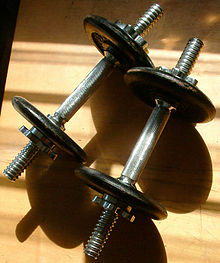Dumbbell: Difference between revisions
No edit summary |
No edit summary |
||
| Line 25: | Line 25: | ||
* [[Kettlebell]] |
* [[Kettlebell]] |
||
* [[weights]] |
* [[weights]] |
||
* [[Nathan Rath]] |
|||
[[Category:Weight training equipment]] |
[[Category:Weight training equipment]] |
||
Revision as of 06:49, 3 May 2007
- For other meanings, see dumbbell (disambiguation).


A dumbbell is a piece of equipment used in weight training, and are considered a type of free weight. It is a weight that is usually held in one hand. Hence, dumbbells normally come in pairs. The forerunner of the dumbbell was used in India for more than a millennium, shaped like a club - so named Indian club. The design of the "Nal" as the equipment was referred to can be seen as a halfway point between a barbell and a dumbbell. It was generally used in pairs, in workouts by wrestlers, bodybuilders, sports players, and others wishing to increase strength and muscle size.
"Dumbbells" as a word originated in Tudor England—the devices used for ringing church bells were widely known for their impact on increasing muscle size, creating a trend in the 16th Century which saw rich young men installing similar devices in their homes, consisting of a pulley with a weighted rope which the user pulled as though he was ringing a church bell[citation needed]. These were known as "bells", but as there were no actual bells on the end of the pulling ropes and were silent, they came to be known colloquially as "dumb-bells". Over the centuries, the pulley and weighted rope fell out of fashion, leaving just the weight.
Dumbbells of the weight type, without the pulley, have been used in America since the 18th Century.
By the early 19th Century, the familiar shape of the dumbbell, with two equal weights attached to a handle, had appeared. There are currently two main types of dumbbell:
- Adjustable dumbbells consist of 14 inch (35 centimetre) long steel bars that are one inch (2.5 centimetres) in diameter. They look like miniature barbells. The centre portion is engraved with a crosshatch pattern (knurling) to help users get a good grip. 1–40 kg of cast iron weight disks (plates) are slid onto the outer portions of the dumbbell to obtain the desired total weight. These weights are secured with clips or collars. A "spinlock" dumbbell's outer portions are threaded, and the collars are large nuts that screw on and secure the plates through friction.
- Fixed-weight dumbbells are weights created in a dumbbell shape. Expensive varieties consist of cast iron coated with rubber for safety. Cheaper versions consist of a rigid plastic shell that is filled with concrete.
Due to their flexibility, dumbbells can be used in all types of resistance weight training, but the most popular dumbbell exercises remain the Bench press and the Biceps curl. Using dumbbells (especially adjustable dumbbells) often without wearing weightlifting gloves causes calluses on the palm of the hand. They are not detrimental to weight training, but some users dislike them and prefer to use weight training gloves.
See also
External Links
Dumbbell Routines Dumbbell Routines
